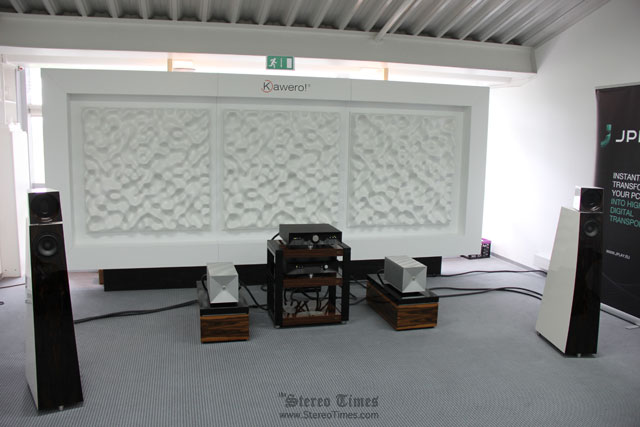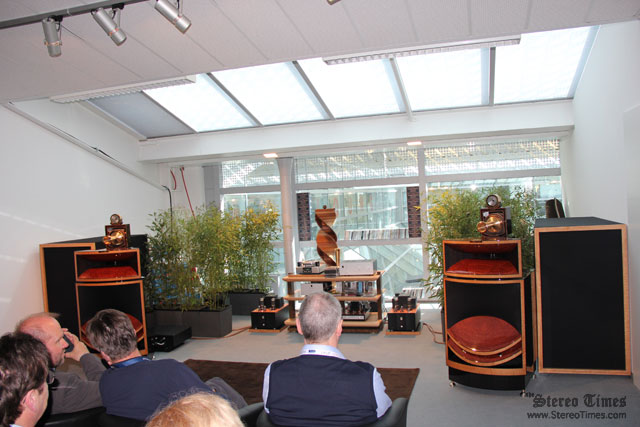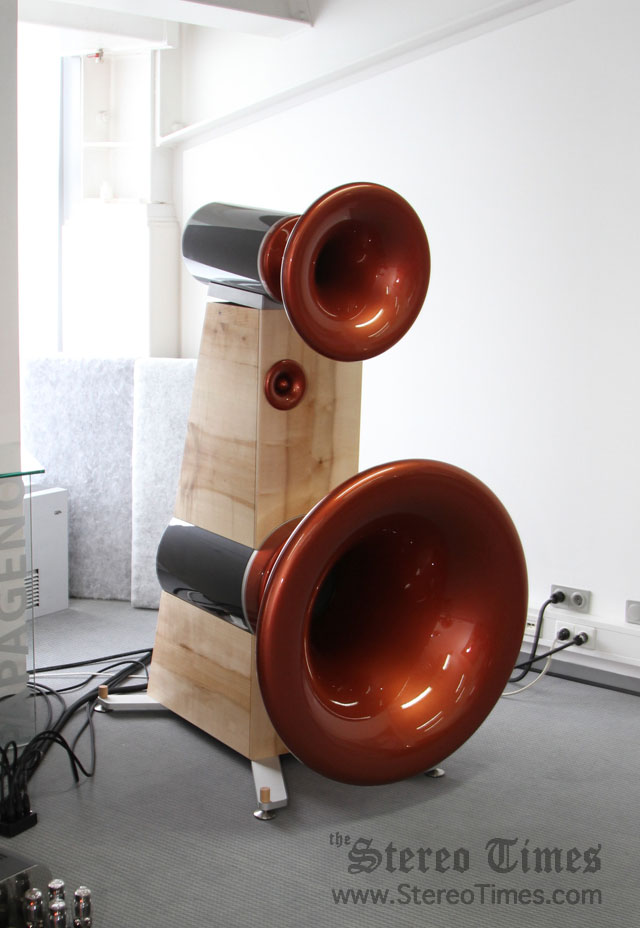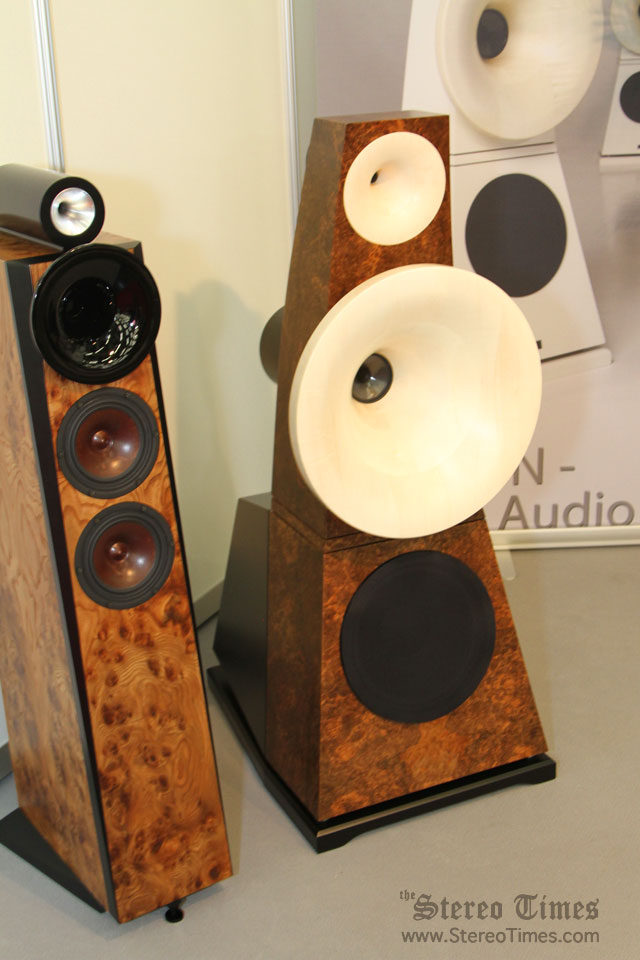Stereo Times’ High End 2014 Munich Report Part II




Auris Audio/Boenicke
Wow! I couldn’t keep my eyes and ears off the gorgeous looking and brilliant sounding electronics from Auris Audio. Stylish Auris Audio hails from Serbia and reminds me of the Absolare but is less expensive. The system included the exquisitely built Auris Audio Forte 6550 Push Pull mono amplifiers (above photo) producing a powerful 100 watts per side (11,880 €), Auris Audio Largo tube line preamplifier with DAC (4,680 €) with a beautiful wooden remote for volume and mute which drove the petite Boenicke W5 mini monitors (3,800 €). The Auris Audio electronics made the diminutive W5 mini monitors sing like full range loudspeakers, it created a big soundstage, witha warm sound, rendering strings in an organic way (Key Kim).
While Key seemed bemused over these gorgeous electronics, I was smitten over the performance of the Boenicke W5 mini-monitors. In fact, the first thing I did upon entering the room was look for the subwoofers because there was NO WAY these little suckers were producing THAT level of bass. No, there were no hidden subs to be found anywhere (and I did look). Upon closer inspection however, I did discover the rubber surrounds on the 6″ bass were fatter than usual. This gave greater extension and thrust which explains the amount of energy the W5’s are capable of. Easily a Show Stopper! (Clement Perry)


Kharma
Kharma show-cased their first lifestyle Butterfly compact high performance audio system. Butterfly is an active digitally controlled 3-way system, a unique combination of satellite speakers and a modest sized subwoofer (10,000 €). Brilliantly, the subwoofer is able to control up to four satellites to make a 5.1 system. The butterfly offers several stand options, a desk stand, wall mounted, floor-standing, and a ceiling mount. The enclosures of the satellite and the subwoofer are both constructed of aluminum with a stunning looking high-gloss painted finish. They utilize a Kharma Composite cone driven midrange unit for the satellites. I wasn’t able to get to hear the Butterfly carefully because in the same room the Kharma Db11-S was playing. Otherwisethe Butterfly sounded very promising.


The Kharma Exquisite Classique 3-way, 3-driver (1” diamond concave tweeter, 7” Omega carbon driver, 12” Nomex-Kevlar woofer) and housed in Kharma’s patented cabinet design – a combination of high pressure laminate panels and irregular shaped cut-outs with de-coupling between panels to guarantee a resonance-dead cabinet – was driven with an Orpheus Heritage Power Amplifier (30k), Orpheus Heritage Preamplifier (33,000 €), and digital sourced from an Orpheus Heritage SACD transport/Heritage DAC combo (30k € and 32k € respectively). The Heritage Power Amplifier drove the Exquisite Classique with speed, resolution, power and authority.


Thrax Audio from Bulgaria powered the Kawero loudspeakers with an effortlessnes I envied. All in all, the sound was pure, transparent and holographic with a beautiful three dimensional soundstage that made me stay here much longer than I should have. The system consisted of meticulously built Thrax Audio Hero mono amps (24k €), that features a powerful 100 watts per side of full Class-A power, a unique two-stage hybrid transformer along with a tube input stage provides the necessary voltage needed. The Dionysos line level preamplifier (15k €) serves as my new reference. A Maximus universal DSP controlled discrete resistor ladder 32bit/384 Khz Audio DAC (24k €), and a Orpheus phono stage (15k), two tube gain-stage boasting zero negative feedback and a passive LCR phono equalizer completed the system.


I was very glad to see a familiar U.S manufacturer Carl Marchisotto from Nola, who showcased his Nola Baby Grand Reference Gold loudspeakers with the Unison Research Absolute 845 Integrated amplifier from Italy. They rendered music beautifully. The Baby Grand Reference Gold is a two-tower system (utilizing four magnesium Alnico woofers, eight open baffle dipole Alnico midrange drivers and true eight ribbon tweeters which extend high frequency response to 100 kHz). The Absolute 845 Integrated incorporated a pair of 845s in a parallel Single-Ended Class-A configuration, producing 40 watts of pure Class-A power. The Absolute 845 Integrated took control of the Nolas very nicely. The sound was open, detailed and boxless with outstanding soundstaging.



The Living Voice/Kondo Audio Note room turned out to be one of my favorites. Kevin Scott, of Definitive Audio once again put together a stunningly gorgeous sounding room. These cost-no object products featured the superbly finished Living Voice Vox Olympian loudspeakers, a four-way horn-loaded loudspeaker coupled with the Elysian horn loudspeaker system, a horn loaded sub woofers. They were driven by the Kondo Audio Note Kagura 211 mono amplifiers and a Kondo KSL-M77 line stage preamplifier producing aglorious and magical 55 watts of pure Class-A. All cabling was Kondo KSL silver. The music reproduction was absolutely captivating with the music flowing through and into this space with an effortlessness that was among the best I have ever heard. For me, and strictly in terms of purity and poise, this was an extraordinary achievement in what is possible from a stereo system.




Once read a thread on the subject of “show me an INexpensive loudspeaker that sounds like a $250k speaker and only then have you got something really special.” Unfortunately, that’s just not the case with regard to the new Estelon Extreme loudspeaker. At over $200k in the USA, my guess is YES, this is extreme. But there’s also a lot to back up why this loudspeaker is so, well… extreme and expensive. First, the Extreme is much bigger than I thought based on the photos. Although its curvy and statuesque in appearance, I think it must be all of 6′ 6″ in height standing right next to it. But here’s the twist, the head unit (bass/midrange/tweeter) adjusts its height electronically to best suit the room and/or desired sweetspot. Internally, the Extreme boasts only the finest internal crossover parts that include noteworthy names like Mundorf and Kubala-Sosna (wiring). Drivers are a mixed blend of Diamond and aluminum composites.
The Vitus MP-S201 stands for Masterpiece and rated at about 600 watts per channel in full Class-A, (at 8 Ohms) and using zero negative feedback. It doesn’t look affordable either whether or not you know its specs. But, it’s a hellova beast of an amplifier that’s for sure at over 250 lbs, and is the full expression of SOTA based on its talented designer Hans Ole Vitus (photo above). As you might have guessed, the room was so noisy and busy that attempting to listen proved futile. Maybe, Vitus will bring his Masterpiece series to the NYC Audio Show in the fall.

 Vitus Audio/ GauderAkustik
Vitus Audio/ GauderAkustikAs expected, the Vitus/GauderAkustic suite looked as impressive as it sounded. The Gauder Akustik Berlina RC9 four-way, utilizes a unique diamond-midrange and diamond-tweeter customized by Accuton. The Berlina RC9’s were effortlessly driven by fabulous sounding Vitus Audio electronics; Hans Ole of Vitus debuted the Signature Series SM-011 mono amplifiers (30,000 €) which deliver 400 watts per side into 8 Ohms. An SL-102 linestage and SCD-025 CD player complete the system. The system was very detailed, transparent, and rendered the music with power and authority and with impressive dynamics.


Alluxity/GauderAkustik
Right next to the Vitus Audio room was the Alluxity Audio room, run by Hans- Ole’s son, Alexander Vitus Mogenson. The Gauder Akustik Berlina RC7 sounded very impressive driven by the Alluxity Power One amp (9,300 €) paired with the Pre One (6,700 €) and show-cased a prototype Media One as the digital source. Alluxity suite produced sound that was detailed, transparent and very dynamic. Debuting at High End 2014 were the IPC Acoustic Panels that everyone here at ST seem to be so fond of (right behind the Gauder Akustik loudspeakers). I haven’t had the chance to try these out as I am having wonderful results with the much smaller and less conspicuous IPC Energizers (reviewed here and here).


Norbert Heuser, director of sales for IPC, was very proud to have an entire display of the IPC technology at High End 2014.



TotalDAC/Engstrom & Engstrom/Bibacord
Once again, I was as impressed with the sound of the TotalDAC room as I was this same time last year. The system was comprised of The Lars Type II (55,000 €) mono amplifiers from Sweden, driving the Kawero Chiara loudspeakers. The source was the TotalDAC d1-Twelve (28,500 €), a state of the art three box system with a discrete Vishay Foil R2R ladder DAC with d1-server (4,990 €) from France. All cabling was by Bibacord of Sweden. The system produced a beautiful soundstage with an analog-like sound from a digital source.



Angstrom Research/Albedo
From Italy came the Albedo Axcentia loudspeakers and Angstrom Research electronics. Axcentia, a three-way floorstander incorporates linear phase loading and a transmission line filtered by resonator (Helmholine system). It utilizes all Accuton ceramic drivers; two 6.5” ceramic woofers; 5” ceramic midrange; and 1.2” ceramic tweeter. These are simply good looking and wonderful sounding speakers. The Angstrom Research Quantum mono amplifiers (72,000 €) paired with their Iridium line preamplifier (13,000 €) produced exceptional sound. Unfortunately I wasn’t able to get any information about the Angstrom Research electronics, not even in their website. One thing for sure; it’s a tube design with excellent sound.


.jpg)
Tidal Audio
Jorn Janczak of Tidal Audio debuted three new products; Tidal Contrava G2 (42,000)the successor of their bestselling speaker; the Contava Diacera was completely redesigned. It uses a new cabinet material, TIRADUR, new drivers, better x-over filters with complete Duelund parts; all are made in-house custom made pure silver binding posts. The cabinets are slightly slimmer and have three degrees more backward slope with new massive isolation stands. The Tidal Contrava X-Tender (TBA), a “Midi T1” system, uses the same technology as his Agoria with long excursion BCC drivers and 4 passive radiators. It utilizes the same cabinet material and design as the Contiva G2. It can be connected completely passively including bass adjustments which are all parallel or active, with Tidal’s LPX technology and full signal control. Finally, the Tidal Presencio DAC (32,000 €) is a discrete dual non oversampling ladder DAC with an autarkic re-clock system which buffers and re-clocks the incoming signals in a unique way.The cables were from Argento Audio of Denmark throughout the system. As I listened I heard the sound that was very open, transparent and authoritative with fine separation of the instruments.


Don’t know much about Trinnov Audio of Germany, but their discussions on Acoustic Correction (not room) and their Optimizer technology they employ looks as innovative and as good as I’ve seen. Of particular interest is how they provide Acoustic Correction of both early reflections and room energy. Their website is quite informative as well (here). If you have room issues are willing to go to any lengths to address them, then Trinnov is a company to place on one’s short list.


Geoff Poor, director of sales for Balanced Audio Technology, gets a much needed rub-down after doing some heaving lifting. It was so good to see BAT at this year’s High End 2014, and upstairs in a large suite (which is nearly impossible unless you know somebody). Geoff Poor may know lots of people but his real talent lies in his Blues collection. Ever in desire to find a great Blues song, just give Geoff a call.


Raidho Acoustic’s Mike Borreson was having a great time discussing the technological marvels of the Raidho D5 – diamond loudspeaker ($210k). But for all its glitz and glory, it was that little birdie sitting right beside it that stole the show in my opinon. The company says this newest mini-monitor will go under the brand name “Scansonic” and will probably retail here in the USA for a hair under $10k. You get a lot of speaker in that little enclosure, I’ll say that with no reservation. In fact, I thought it sounded surprisingly good after listening to the D5’s in side by side comparisons. No, it doesn’t nearly have the weight and solidity of the bigger more expensive D5, but what it does offer is remarkable depth of stage, image specificity and clarity. Not bad for its asking price.


In many ways, the Amati Systems of Switzerland, that was featured in the Werner Barden System (WBS) suite, stole the show for me. Here’s an loudspeaker that is very reminiscent of the famous B&W Nautilus of yesteryear. Yet, this is speaker system is configured to be fully active dependent on the users requirements and budget. Though only on static display, I was nevertheless impressed by its build and overall appearance. Not too big, bulky or gaudy. It looked as though it could perform as its technical claims state.
Here’s a blurb from the Amati website “For decades little has changed in speaker cabinet design and the materials to construct them. Virtually all speaker cabinets to date are made of wood, a composite of many cell types and molecular structures: These resonate mainly between 50 and 400hz exactly in the working area of all low frequency drivers where the pressure is highest. This unavoidably causes cabinet resonance and distortion. That, plus the obvious difficulty of shaping a complex form from wood, inspired us to seek a novel solution for optimum performance. After extensive research and noting the imperfect characteristics of wood the Amati Engineering developed a resonance free composite material. This combined with our moulding technique provides the perfect resonance free and acoustically correct result.Inspired by creatures of nature we opted for the “snail-shape” housing, a perfect structure that deals with the involvement of sound waves at different frequencies. In the snail design, no one side is exactly parallel to another, changing shape all the time. This makes the structure extremely strong, resonance free and avoids standing waves unlike any other man-made shape or construction. A huge internal volume of 100-litres is essential to reproduce frequencies down to 28Hz whilst keeping the design elegant. The cabinet’s base and front rings are CNC machined out of “first grade” solid aluminum blocks, resulting in a very strong, elegant and modern look with no externally visible screws. ALL capacitors utilized in the crossover filters are Silver Z-Cap and Silver gold Z-cap and all wiring is 99.99% pure silver wire.”


The Amati Team of designers also build this gorgeous looking tube amplifier (90,000 euro), built out a solid block of aluminum using a pair of 845 SE tubes. I spent an ample amount of time listening to the Amati’s through a pair of Franco Serblin Ktema loudspeakers ($40k) compliments of Wywire cabling. The music of Mark Isham’s Blue Sun was remarkably fluid, never intrusive or excessively overbearing no matter how much the volume was turned up or how close I sat to the system. The beauty of those 845 SE’s was immediately apparent as well because the overall sound was just tonally right.


Visited the German Physik’s suite where I got a chance to see all the new and attractive Grandioso series from Esoteric. The system featured the German Physik PQS-302 speaker system driven by a pair of Grandioso M-1 mono amps, C-02 preamplifier, Grandioso P-1 SACD/CD-Transport, Grandioso D-1 Mono-D/A-Converters slaved to a model G-01 Master Clock. Of course, I never got the chance to listen since this room was buzzing with activity. I do however like the look of the Grandioso components.


Of all the rooms I visit while traversing through Munich, the one person I am always in awe of, music-wise, is the multi-Grammy Award winning Alan Wise and his Ocean Way loudspeakers. Sides is also very fond of Viola electronics and he’s been using it since our first chance encounter at CES back in ’08 or thereabouts. Here in this suite, he was also having some positive and interesting observations about the Artesenia platforms and isolation racks here as well.
It was in ’08, I think when I first realized after a short discussion about his interest in building high efficiency horn-loaded loudspeakers did I realize his star studded background in studio recording. Consider this, Sides has recorded with such luminaries such as: Count Basie, Duke Ellington, Frank Sinatra, Ella Fitzgerald, Sarah Vaughn, Phil Collins, Michael Jackson, Eric Clapton to name but a few. Alan Sides epitomizes the notion that this hobby is about THE MUSIC FIRST, which becomes evident by the music he plays. Whenever I walk into his room, he’s points directy to the music FIRST. Something he’s dying for me to hear to hear that he just either just recorded or is in the middle of mixing in his studio. And, as usual, I’m left slack jawed. So much so, I forgot to ask him anything about loudspeakers, electronics or anything else besides the MUSIC.

As to be expected with shows of this magnitude (and not to mention, high entrance fee), smaller, less-expensive venues like Hifi Delux hosted their own event at a nearby Marriott hotel. Getting there was made easy compliments of a free shuttle service directly across the street from the MOC.



Unfortunately, the space was unusually tight, dark and dank. Nothing like the MOC’s open and airy showrooms. However, that didn’t lower the spirit of LaRosita’s designer Dan Bellity who had added a few new items to his growing product line. What caught my fancy was the new LaRosita mono amplifiers (above), driving the new LaRosita Ipenema loudspeakers ($45k). Knowing Bellity’s penchant for high sensitivity, high purity type transducers it was no surprise to find out his newest reference would incorporate a dual concentric driver and be driven by a solid-state device. The sound, despite the less than ideal surroundings, was open, dynamically charged and delicate when the music called for it. In a word: stellar.



Another demostration that proved to be worth the travel away from the MOC and NOT provide free shuttle service was the new Swiss-built Steinheim Reference loudspeaker. The venue was the hotel Kempinski located downtown Munich on Maximilianstrasse. The room also featured Audio Consulting of Switzerland’s new Meteor Autoformer Passive preamp, Silverock phonostage and electronics from Nagra. All in all, it appeared the entire layout came out of Switzerland. I never really got the chance to sit and listen as I wanted due to time constraints and all the small talk surrounding the debut of these products. But I will admit, I’m a long time fan of Audio Consulting and think they’ve got my pick (alongside Audio Note) for what’s sounds actually closest to pure and natural. And I do not think these guys were far from achieving that once again. My only wish was that I could have had a chance to sit in that sweet spot. Awesome!!
Finally, I was constantly reminded (mostly by their odd appearance) that High End 2014 had the greatest consortium of high-sensitivity loudspeaker manufacturers in the world under one roof. Always fond of their unrivaled dynamic capability, see-through clarity and tonal acuity – not to mention their wild and assorted appearance – I thought I would share some of those I captured here as a parting farewell….until next year!













Stereo Times Masthead
Publisher/Founder
Clement Perry
Editor
Dave Thomas
Senior Editors
Frank Alles, Mike Girardi, Russell Lichter, Terry London, Moreno Mitchell, Paul Szabady, Bill Wells, Mike Wright, and Stephen Yan,
Current Contributors
David Abramson, Tim Barrall, Dave Allison, Ron Cook, Lewis Dardick, John Hoffman, Dan Secula, Don Shaulis, Greg Simmons, Eric Teh, Greg Voth, Richard Willie, Ed Van Winkle, Rob Dockery, Richard Doran, and Daveed Turek
Site Management Clement Perry
Ad Designer: Martin Perry





Be the first to comment on: Stereo Times’ High End 2014 Munich Report Part II